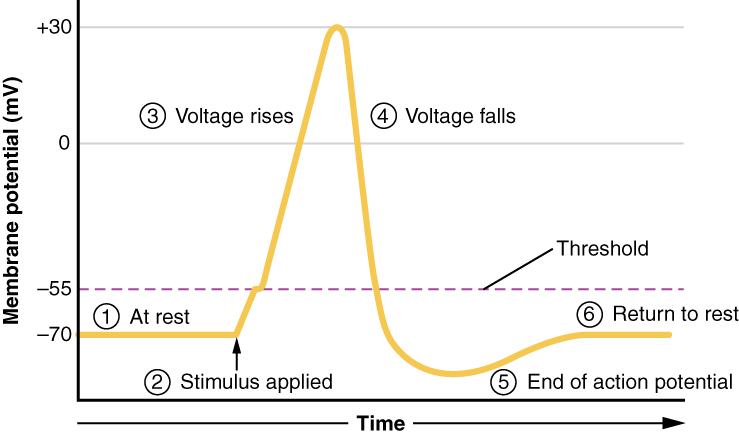| << Chapter < Page | Chapter >> Page > |
As we have seen, the depolarization and repolarization of an action potential are dependent on two types of channels (the voltage-gated Na + channel and the voltage-gated K + channel). The voltage-gated Na + channel actually has two gates. One is the activation gate , which opens when the membrane potential crosses -55 mV. The other gate is the inactivation gate , which closes after a specific period of time—on the order of a fraction of a millisecond. When a cell is at rest, the activation gate is closed and the inactivation gate is open. However, when the threshold is reached, the activation gate opens, allowing Na + to rush into the cell. Timed with the peak of depolarization, the inactivation gate closes. During repolarization, no more sodium can enter the cell. When the membrane potential passes -55 mV again, the activation gate closes. After that, the inactivation gate re-opens, making the channel ready to start the whole process over again.
The voltage-gated K + channel has only one gate, which is sensitive to a membrane voltage of -50 mV. However, it does not open as quickly as the voltage-gated Na + channel does. It might take a fraction of a millisecond for the channel to open once that voltage has been reached. The timing of this coincides exactly with when the Na + flow peaks, so voltage-gated K + channels open just as the voltage-gated Na + channels are being inactivated. As the membrane potential repolarizes and the voltage passes -50 mV again, the channel closes—again, with a little delay. Potassium continues to leave the cell for a short while and the membrane potential becomes more negative, resulting in the hyperpolarizing overshoot. Then the channel closes again and the membrane can return to the resting potential because of the ongoing activity of the non-gated channels and the Na + /K + pump.
All of this takes place within approximately 2 milliseconds ( [link] ). While an action potential is in progress, another one cannot be initiated. That effect is referred to as the refractory period . There are two phases of the refractory period: the absolute refractory period and the relative refractory period . During the absolute phase, another action potential will not start. This is because of the inactivation gate of the voltage-gated Na + channel. Once that channel is back to its resting conformation (less than -55 mV), a new action potential could be started, but only by a stronger stimulus than the one that initiated the current action potential. This is because of the flow of K + out of the cell. Because that ion is rushing out, any Na + that tries to enter will not depolarize the cell, but will only keep the cell from hyperpolarizing.


Notification Switch
Would you like to follow the 'Anatomy & Physiology' conversation and receive update notifications?